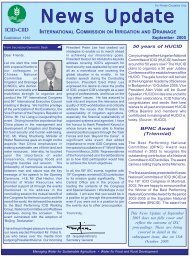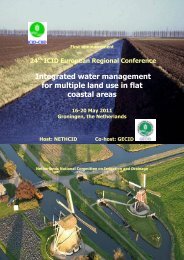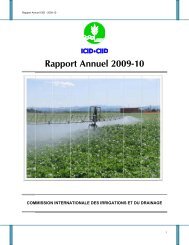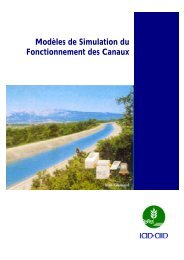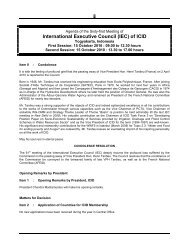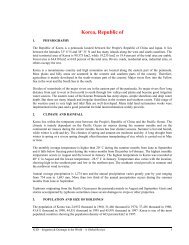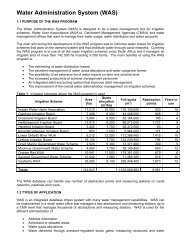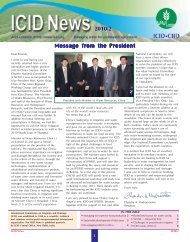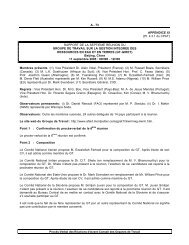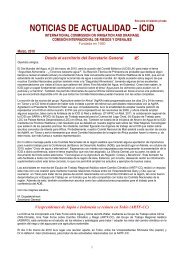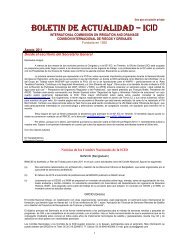Spain and Turkey (PDF 601 KB) - International Commission on ...
Spain and Turkey (PDF 601 KB) - International Commission on ...
Spain and Turkey (PDF 601 KB) - International Commission on ...
You also want an ePaper? Increase the reach of your titles
YUMPU automatically turns print PDFs into web optimized ePapers that Google loves.
ANNEX 9ARTICLES<str<strong>on</strong>g>Spain</str<strong>on</strong>g><str<strong>on</strong>g>Turkey</str<strong>on</strong>g>
ARTICLESPAIN
1ABSTRACTBENEFITS AND CONCERNS ABOUT DAMS IN SPAINL. BergaChairman, Spanish Nati<strong>on</strong>al Committee <strong>on</strong> Large Dams (SPANCOLD)In <str<strong>on</strong>g>Spain</str<strong>on</strong>g>, due to the high irregularity in the time of the flow of the rivers, <str<strong>on</strong>g>and</str<strong>on</strong>g> to the str<strong>on</strong>g spatialunbalanced renewable water resources, it has been necessary to c<strong>on</strong>struct numerous largedams. The c<strong>on</strong>structi<strong>on</strong> of dams in <str<strong>on</strong>g>Spain</str<strong>on</strong>g> began in Roman times, of which there still remain todate in operati<strong>on</strong> the Cornalvo <str<strong>on</strong>g>and</str<strong>on</strong>g> Proserpina Dams. At the present time there are in <str<strong>on</strong>g>Spain</str<strong>on</strong>g>1,200 large dams of which 21 are under c<strong>on</strong>structi<strong>on</strong>, with a total reservoir capacity of some56,500 Hm 3 , which have made it possible to pass from a natural regulati<strong>on</strong> of <strong>on</strong>ly 8% to a realregulati<strong>on</strong> of more than 40% of the water resources, <str<strong>on</strong>g>and</str<strong>on</strong>g> thus situating the country in the settingof the mean natural regulati<strong>on</strong> of the European countries.In this paper the divers purposes of the dams in <str<strong>on</strong>g>Spain</str<strong>on</strong>g> are described, <str<strong>on</strong>g>and</str<strong>on</strong>g> a quantitativeevaluati<strong>on</strong> is made of the benefits which the dams represent in irrigati<strong>on</strong>, water supply, water forindustrial uses, hydropower <str<strong>on</strong>g>and</str<strong>on</strong>g> other applicati<strong>on</strong>s, which in total suppose about 6% of the GrossAdded Value (GAV). Likewise, the benefits of the dams in Flood C<strong>on</strong>trol are described.On the other h<str<strong>on</strong>g>and</str<strong>on</strong>g>, diverse c<strong>on</strong>cerns with reference to dams are analysed, the most significantbeing that of Dam Safety <str<strong>on</strong>g>and</str<strong>on</strong>g> the Envir<strong>on</strong>mental aspects. The new legislati<strong>on</strong>s, guidelines <str<strong>on</strong>g>and</str<strong>on</strong>g>programmes <strong>on</strong> Dam Safety are described which are being complemented by n<strong>on</strong>-structuralmeasures, such as Dam Hazard classificati<strong>on</strong> <str<strong>on</strong>g>and</str<strong>on</strong>g> the Emergency Acti<strong>on</strong> Plans. Also theexperiences of the studies of Envir<strong>on</strong>mental Impact Assessment (EIA) <str<strong>on</strong>g>and</str<strong>on</strong>g> the correctivemeasures are analysed.1. INTRODUCTIONThe peculiar locati<strong>on</strong> of the Iberian Peninsula, to the South West of Europe <str<strong>on</strong>g>and</str<strong>on</strong>g> to the North ofAfrica causes the climatology of <str<strong>on</strong>g>Spain</str<strong>on</strong>g> to present some very specific <str<strong>on</strong>g>and</str<strong>on</strong>g> varied characteristicswith the influence of the Atlantic fr<strong>on</strong>ts, the Mediterranean storms, the hot air masses comingfrom the North of Africa, or the cold air coming from North <str<strong>on</strong>g>and</str<strong>on</strong>g> Central Europe. All this gives riseto a regime of rainfall <str<strong>on</strong>g>and</str<strong>on</strong>g> flows in the rivers with a very high irregularity in time <str<strong>on</strong>g>and</str<strong>on</strong>g> space. Timeirregularity, with pr<strong>on</strong>ounced interannual variati<strong>on</strong>s which can give rise to l<strong>on</strong>g periods of drought,<str<strong>on</strong>g>and</str<strong>on</strong>g> also very important seas<strong>on</strong>al variati<strong>on</strong>s with c<strong>on</strong>siderable low-water during the summerm<strong>on</strong>ths. Space irregularity: the northern half of the country having abundant water resources, asopposed to the scarcity of the greater part of the basins of the Mediterranean watershed.The rainfall average in <str<strong>on</strong>g>Spain</str<strong>on</strong>g> is 685 mm/year, which gives rise to total renewable resources ofsome 112 Km 3 /year. This represents some per capita resources of some 3,000 m 3 /perpers<strong>on</strong>/year, a figure which is of the same order of magnitude as the average of the countries ofthe European Uni<strong>on</strong> (3,200m 3 /per pers<strong>on</strong>/year). Nevertheless, the distributi<strong>on</strong> of the per capitanatural resources (Table Nº 1) show a great irregularity in space, which supposes that in theSpanish peninsula the Internal Basins of Catal<strong>on</strong>ia are classified hydrologically as a z<strong>on</strong>e ofAbsolute water Scarcity (with less than 500 m 3 / per pers<strong>on</strong>/ per year of renewable resources), theBasins of the Segura <str<strong>on</strong>g>and</str<strong>on</strong>g> Jucar classified as of water scarcity (with some renewable resources ofbetween 500 <str<strong>on</strong>g>and</str<strong>on</strong>g> 1,000 m 3 /per pers<strong>on</strong>/year), <str<strong>on</strong>g>and</str<strong>on</strong>g> the Basins of the South <str<strong>on</strong>g>and</str<strong>on</strong>g> Guadalquivir as ofwater stress (with values of between 1,000 <str<strong>on</strong>g>and</str<strong>on</strong>g> 1,700m 3 /per pers<strong>on</strong>/year).
2TABLE Nº 1. DISTRIBUTION OF THE RENEWABLE WATER RESOURCES PER CAPITABasinPopulati<strong>on</strong>(mill.inhabitants)(1996)Renewable ResourcesTotals(Hm 3 /year)Per Capitam 3 /pers<strong>on</strong>/ yearNorth: 6.75 42,088 6,235Duero: 2.25 15,168 6,741Tagus: 6.36 12, 858 2,022Guadiana: 1.66 6,165 3,714Guadalquivir: 4.90 7,771 1,586South: 2.07 2,418 1,168Segura: 1.36 1,000 735Jucar: 4.19 4,142 988Ebro: 2.76 18,198 6,593Interior Basins of Catal<strong>on</strong>ia: 6.17 2,780 450Total Peninsula 38.47 112,588 2,927On the other h<str<strong>on</strong>g>and</str<strong>on</strong>g>, the flow regime of the rivers presents a high irregularity in time, which givesrise to reduced availabilities of resources in a natural regime, with a total of some 9,200 Hm 3 /year(8.3% of the renewable resources) which would give rise to some mean per capita availabilities of<strong>on</strong>ly 240m 3 /per pers<strong>on</strong>/year, as compared with the 1,000m 3 /per pers<strong>on</strong>/year which is c<strong>on</strong>sideredbasic <strong>on</strong> a world level in order to cover the supply necessities. (1) (Table Nº. 2).These basic data of the renewable resources together with the characteristic circumstances ofthe supply of water are clear indicati<strong>on</strong>s of the Spanish situati<strong>on</strong>, in which, in order to be able toattend the water dem<str<strong>on</strong>g>and</str<strong>on</strong>g>s, it has been necessary to carry out important hydraulic works <str<strong>on</strong>g>and</str<strong>on</strong>g> thec<strong>on</strong>structi<strong>on</strong> of numerous large dams.2. LARGE DAMS IN SPAINThe c<strong>on</strong>structi<strong>on</strong> of large dams began in <str<strong>on</strong>g>Spain</str<strong>on</strong>g> in the roman times, although in that period theywere not placed in the main rivers, of which still remain the marvellous dams of Proserpina <str<strong>on</strong>g>and</str<strong>on</strong>g>Cornalvo. The Arabs followed with their systems of irrigati<strong>on</strong> <str<strong>on</strong>g>and</str<strong>on</strong>g> their delightful dominatingc<strong>on</strong>trols over the water <str<strong>on</strong>g>and</str<strong>on</strong>g> its distributi<strong>on</strong>, from which afterwards much was learned during manyyears by the settlers of the south-eastern z<strong>on</strong>es of the peninsula. Later, in the XVI <str<strong>on</strong>g>and</str<strong>on</strong>g> XVIIcenturies were developed the innovatory experiences of arch dams such as are the magnificentexamples of the Tibi, Elche <str<strong>on</strong>g>and</str<strong>on</strong>g> Relleu Dams, which would be a world reference during more than200 years. They also carried out daring technical works, the El Gasco <str<strong>on</strong>g>and</str<strong>on</strong>g> Puentes Dams, whichwith their failures gave rise to the need of basing the technique of the project <str<strong>on</strong>g>and</str<strong>on</strong>g> c<strong>on</strong>structi<strong>on</strong> ofdams <strong>on</strong> more scientific bases (2).
3TABLE Nº 2. WATER RESOURCES IN NATURAL REGIMEBasinNaturalRegime(Hm 3 /year)Populati<strong>on</strong>(mill. inhabitants)(1996)Resources per capitam 3 /pers<strong>on</strong>/yearNorth: 2,550 6.75 378Duero: 840 2.25 373Tagus: 360 6.36 57Guadiana: 10 1.66 6Guadalquivir: 920 4.90 188South: 50 2.07 24Segura: 130 1.36 96Jucar: 710 4.19 169Ebro: 3,460 2.76 1,254Internal BasinsCatal<strong>on</strong>iaTOTAL SPANISHPENINSULA160 6.17 269,190 38.47 239At the end of the XIXth. Century there existed in <str<strong>on</strong>g>Spain</str<strong>on</strong>g> references of some 90 dams (3) of which58 dams are actually in operati<strong>on</strong>. In general, they dealt with reservoirs of reduced dimensi<strong>on</strong>s,<str<strong>on</strong>g>and</str<strong>on</strong>g> <strong>on</strong>ly three dams (Puentes, Valdeinfierno <str<strong>on</strong>g>and</str<strong>on</strong>g> Villar)had a reservoir capacity superior to 10Hm 3 . The capacity of the reservoirs created by these 58 dams was of 108 Hm 3 .The Fig. 1 shows the evoluti<strong>on</strong> of the number of large dams <str<strong>on</strong>g>and</str<strong>on</strong>g> of the capacity of their reservoirsduring the XX th century (1900-2000). During the first third of this century the c<strong>on</strong>structi<strong>on</strong> of damswent following the ideas of the Hydraulic Policy of the regenerati<strong>on</strong>ists, who based themselves <strong>on</strong>the belief that the development of <str<strong>on</strong>g>Spain</str<strong>on</strong>g> should be based <strong>on</strong> an adequate farming with thecarrying out of extensive irrigati<strong>on</strong>s for which it was necessary to regulate the water of the rivers,<str<strong>on</strong>g>and</str<strong>on</strong>g> which were expressed by Rafael Gasset <str<strong>on</strong>g>and</str<strong>on</strong>g> Joaquín Costa (4) <str<strong>on</strong>g>and</str<strong>on</strong>g> which culminated withthe hydrological planificati<strong>on</strong>, in which the dams played a fundamental part. So was born, with thesupport <str<strong>on</strong>g>and</str<strong>on</strong>g> directi<strong>on</strong> of D<strong>on</strong> Rafael Benjumea <str<strong>on</strong>g>and</str<strong>on</strong>g> D<strong>on</strong> Indalecio Prieto, the first Nati<strong>on</strong>alHydrological Plan, drawn up in the year 1933 by D<strong>on</strong> Manuel Lorenzo Pardo (5). Afterwards, theSpanish Civil War <str<strong>on</strong>g>and</str<strong>on</strong>g> the post-war period supposed an important restraint for the c<strong>on</strong>structi<strong>on</strong> ofnew works. In the year 1950 there existed 276 large dams which created 6,142 Hm 3 of capacityof reservoirs. With this in the first half of the century 218 dams had been c<strong>on</strong>structed, whichsupposed a mean of 4 large dams per year, which had been maintained practically c<strong>on</strong>stant overthe length of the 50 years, except for the interval of the years 1935-1940.The reservoir capacityhad increased by 6,034Hm 3 . which had supposed a mean of some 120 Hm 3 per year.With the start of the sec<strong>on</strong>d half of the century the c<strong>on</strong>structi<strong>on</strong> of dams experienced a veryspectacular advance, particularly from the years 1955 to 1970, <str<strong>on</strong>g>and</str<strong>on</strong>g> due fundamentally to thereservoirs with hydropower purposes, in which the number of dams was multiplied by 2.4, <str<strong>on</strong>g>and</str<strong>on</strong>g> thecapacity of the reservoirs was multiplied sixfold (Table Nº3.). The mean increase of the number ofdams per year, in this period, has been maintained practically c<strong>on</strong>stant <str<strong>on</strong>g>and</str<strong>on</strong>g> has been of some 18dams per year.
4TABLE Nº 3. EVOLUTION OF THE SPANISH LARGE DAMS. (1950-2000)PERIODNUMBER OFLARGE DAMSINCREASENº MEANPER YEARRESERVOIRCAPACITY(Hm 3 )INCREASEMEANCAPACITY PERYEAR (Hm 3 )BEFORE 1950 276 4 6.142 12050-60 464 19 18.167 1.20060-70 666 20 36.919 1.87570-80 859 19 41.717 48080-90 1.016 16 49.315 76090-00 1.196 18 56.500 720MEAN 50-00 18 1.000The average increase in reservoir capacity has been of some 1,000 Hm 3 per year, with maximumvalues in the decade of the 1960‘s with some 1,875 Hm 3 per year. It should be pointed out that inthe decade of the 1990‘s the number of dams in c<strong>on</strong>structi<strong>on</strong> has diminished significantly, sincewhile in the year 1991 there were 62 dams in c<strong>on</strong>structi<strong>on</strong>, at the present time there are <strong>on</strong>ly 31large dams.
5At the present time there are some 1,200 large dams in <str<strong>on</strong>g>Spain</str<strong>on</strong>g> (1,175 dams in operati<strong>on</strong> <str<strong>on</strong>g>and</str<strong>on</strong>g> 21under c<strong>on</strong>structi<strong>on</strong>), which create some reservoirs with a capacity of some 56,500 Hm 3 . Theirregulati<strong>on</strong> capacity is of some 45,000 Hm 3 /year - that is to say a 40% of the renewable waterresources, although the rate of regulati<strong>on</strong> is very varied in the different basins depending <strong>on</strong> itsmorphological <str<strong>on</strong>g>and</str<strong>on</strong>g> hydrological characteristics <str<strong>on</strong>g>and</str<strong>on</strong>g> <strong>on</strong> the determinants <str<strong>on</strong>g>and</str<strong>on</strong>g> incidents of thedem<str<strong>on</strong>g>and</str<strong>on</strong>g>s (Table Nº 4 ) (8).With this, it has been possible to pass from a natural regulati<strong>on</strong> of <strong>on</strong>ly 9% of the resources,which was totally insufficient, to some available resources of 40% of the mean annual run off,which has situated us in the setting of the mean availabilities of the European countries. The 98%of the total reservoir capacity is c<strong>on</strong>centrated in the 300 reservoirs which have a capacity superiorto 10 Hm 3 . With this number of dams, <str<strong>on</strong>g>Spain</str<strong>on</strong>g> occupies the first place am<strong>on</strong>g the Europeancountries, <str<strong>on</strong>g>and</str<strong>on</strong>g> the fourth in the world ranking, after the U.S.A., India <str<strong>on</strong>g>and</str<strong>on</strong>g> China. (6,7).TABLE Nº 4. RESERVOIR CAPACITY AND REGULATED WATER RESOURCES AVAILABLEIN THE HYDROGRAPHIC BASINSBASINRENEWABLEWATERRESOURCES(Hm 3 /year)RESERVOIRCAPACITY(Hm 3 )AVAILABLERESOURCES(Hm 3 /year)REGULATION%North 29.616 3.721 5.224 17Duero 15.168 7.667 8.128 54Tagus 12.230 11.135 7.071 57Guadiana 6.168 9.619 2.975 48Gadalquivir 7.978 8.867 3.632 46South 2.483 1.319 504 20Segura 1.000 1.223 725 72Jucar 4.142 3.349 1.985 48Ebro 18.217 7.702 12.998 71Internal Basinsof Catal<strong>on</strong>ia2.780 772 1.115 41Galicia Coast 12.642 688 1.493 11TOTAL 112.424 56.062 45.850 40.7The greater part of the Spanish dams, the 72%, (64% gravity, 5% arch dams, 3% buttress) are ofc<strong>on</strong>crete or mas<strong>on</strong>ry, as opposed to 28% of embankment dams (17% earth, 11% rockfill). This isdue to, in general, the characteristics of the foundati<strong>on</strong>s having been good, <str<strong>on</strong>g>and</str<strong>on</strong>g> that the dams ofc<strong>on</strong>crete are less vulnerable to the extreme floods so characteristic of the regime of the rivers.The 58% of the dams have a height of less than 30mts., <str<strong>on</strong>g>and</str<strong>on</strong>g> <strong>on</strong>ly 15% have a height superior to60 Mts. There exist 40 large dams with a height greater than 100mts., the Almendra Dam,c<strong>on</strong>structed in 1970, having the greatest height with 202mts. The reservoir of greatest capacity isthat of La Serena, c<strong>on</strong>structed in the year 1989, with 3,232 Hm 3 . There are three reservoirs withcapacities greater than 2,000Hm 3 (La Serena 3,232 Hm 3 , José Mª Oriol -Alcántara 3,162Hm 3 <str<strong>on</strong>g>and</str<strong>on</strong>g>Almendra 2,649 Hm 3 ), <str<strong>on</strong>g>and</str<strong>on</strong>g> six reservoirs with capacities between 1,000Hm 3 <str<strong>on</strong>g>and</str<strong>on</strong>g> 2,000Hm 3 (Buendia, Cíjara, Mequinenza, Valdecañas, Ricobayo <str<strong>on</strong>g>and</str<strong>on</strong>g> Alarcón). The populati<strong>on</strong> of Spanish
6dams is growing old. At the present time 22% of the dams have more than 50 years old, <str<strong>on</strong>g>and</str<strong>on</strong>g> 55%more than 30 years. For this reas<strong>on</strong>, in the future, greater efforts must be dedicated to themaintenance of the dams, to their rehabilitati<strong>on</strong>, as also to the upgrading of dams <str<strong>on</strong>g>and</str<strong>on</strong>g> reservoirsto the new st<str<strong>on</strong>g>and</str<strong>on</strong>g>ards, more dem<str<strong>on</strong>g>and</str<strong>on</strong>g>ing every day.The greater part of the dams <str<strong>on</strong>g>and</str<strong>on</strong>g> their reservoirs, 75% of the dams, some 900 dams, have asingle purpose. This single purpose is in the first place that of irrigati<strong>on</strong> (in 41% of the cases),followed by hydropower (28%), the water supply (26%), the flood c<strong>on</strong>trol (2%) <str<strong>on</strong>g>and</str<strong>on</strong>g> others such asrecreati<strong>on</strong>, navigati<strong>on</strong>, fisheries, etc., with 3%. The remaining 25% of dams corresp<strong>on</strong>d toreservoirs with multiple purposes, the mean being two objectives per dam. Am<strong>on</strong>g these, that ofirrigati<strong>on</strong> c<strong>on</strong>stitutes the first purpose (with 40%), followed by the water supply (29%), hydropower(21%), flood c<strong>on</strong>trol (2%) <str<strong>on</strong>g>and</str<strong>on</strong>g> others. So then, c<strong>on</strong>sidering all the purposes of the dams <str<strong>on</strong>g>and</str<strong>on</strong>g> theirreservoirs, the first purpose of the Spanish dams is that of irrigati<strong>on</strong> (with 40% of the cases),followed by that of water supply (27%), hydropower (25%) <str<strong>on</strong>g>and</str<strong>on</strong>g> flood c<strong>on</strong>trol (2%).3. BENEFITS OF DAMS AND RESERVOIRSIn <str<strong>on</strong>g>Spain</str<strong>on</strong>g> the c<strong>on</strong>structi<strong>on</strong> of large dams has been <strong>on</strong>e of the characteristics <str<strong>on</strong>g>and</str<strong>on</strong>g> topics that hasmarked the Spanish hydraulic traditi<strong>on</strong>, str<strong>on</strong>gly c<strong>on</strong>diti<strong>on</strong>ed by the great space <str<strong>on</strong>g>and</str<strong>on</strong>g> timeirregularity of the natural flow regime of the rivers. The existing dams produce important benefitsin the ec<strong>on</strong>omy of the country, <str<strong>on</strong>g>and</str<strong>on</strong>g> have been a determining factor in the grade of developmentobtained during the last decades. In the analysis of ec<strong>on</strong>omic viability of each dam the specificstudies are developed in which are shown the benefits that are going to be obtained with theregulati<strong>on</strong> of the waters. Nevertheless, we are not going to refer here to the presentati<strong>on</strong> of thevarious most significant cases, but in a general manner we are going to present an ec<strong>on</strong>omicevaluati<strong>on</strong> of a global nature, quantifying the ec<strong>on</strong>omic benefits which the regulated water in thereservoirs produces in the diverse sectors of the Spanish ec<strong>on</strong>omy, such as the irrigati<strong>on</strong>, watersupply, water for industrial uses, hydropower, <str<strong>on</strong>g>and</str<strong>on</strong>g> the uses for refrigerati<strong>on</strong>, recreati<strong>on</strong>alpurposes <str<strong>on</strong>g>and</str<strong>on</strong>g> other applicati<strong>on</strong>s. For this, the aspects relative to the regulated water as aproductive ec<strong>on</strong>omic factor are going to be analysed, quantifying its c<strong>on</strong>tributi<strong>on</strong> to the GROSSADDED VALUE at the market value (GAV). Also the benefits of the dams in flood c<strong>on</strong>trol aregoing to be described. The present situati<strong>on</strong> of the water dem<str<strong>on</strong>g>and</str<strong>on</strong>g>s in the diverse sectors is asfollows (8):SECTORWATER DEMAND(1998) (Hm 3 /year)Irrigati<strong>on</strong> 24,094Water Supply 4,667Water for industrial uses 1,647Hydropower (flexible) 16,000Other uses (refrigerati<strong>on</strong>, etc.) 4,915The most important dem<str<strong>on</strong>g>and</str<strong>on</strong>g> is that for irrigati<strong>on</strong>, which represents almost 80% of the dem<str<strong>on</strong>g>and</str<strong>on</strong>g>sfor c<strong>on</strong>sumptive uses, <str<strong>on</strong>g>and</str<strong>on</strong>g> of the order of 47% of the total of the c<strong>on</strong>sumptive <str<strong>on</strong>g>and</str<strong>on</strong>g> n<strong>on</strong>c<strong>on</strong>sumptivedem<str<strong>on</strong>g>and</str<strong>on</strong>g>s, excluding the envir<strong>on</strong>mental dem<str<strong>on</strong>g>and</str<strong>on</strong>g>s.The ec<strong>on</strong>omic studies detailed sector by sector which have been carried out in <str<strong>on</strong>g>Spain</str<strong>on</strong>g>, based <strong>on</strong>the productivity of the water stored in the reservoirs ( 9 ), can be synthesized in the values whichare shown in the Table nº 5.
7TABLE Nº 5. ECONOMIC VALUE OF THE REGULATED WATER FOR THE RESERVOIRSSECTOR M YEAR VALUE m 3 GAV (%)IRRIGATION 5,000 0.26 1.06WATER SUPPLY 5,225 1.4 1.10WATER FORINDUSTRIAL USES11,529 7.0 2.40HYDROPOWER 3,290 0.21 0.70REFRIGERATION ANDOTHER USES2,949 0.6 0.63TOTAL 27,993 MEAN 0.55 m 3 5.89%So then, the ec<strong>on</strong>omic value of the water regulated by the reservoirs can be estimated in some28 B year, which represents nearly 6 % of the GAV. That signifies a mean value of the regulatedwater for the different uses of 0.55 m 3 .Apart from the benefits of the water regulated by the reservoirs that can be quantifiedec<strong>on</strong>omically, the benefits that the dams <str<strong>on</strong>g>and</str<strong>on</strong>g> the reservoirs produce in the flood c<strong>on</strong>trol can alsobe cited. In <str<strong>on</strong>g>Spain</str<strong>on</strong>g> the floods c<strong>on</strong>stitute the most important natural disaster <str<strong>on</strong>g>and</str<strong>on</strong>g> represent a graveec<strong>on</strong>omic <str<strong>on</strong>g>and</str<strong>on</strong>g> social problem. There references of more than 2,400 floods occurred in the lastfive hundred years, which signifies an average of five important floods per year. The floodsproduce a mean loss of life of 30 pers<strong>on</strong>s per year, together with material damages of 500 Myear.Am<strong>on</strong>g the diverse measures for reducing the damages produced by the floods, the dams <str<strong>on</strong>g>and</str<strong>on</strong>g>reservoirs c<strong>on</strong>stitute a very efficient structural acti<strong>on</strong>, as they are the <strong>on</strong>ly measure that can storewater in a very significant manner, modifying the hydrographs <str<strong>on</strong>g>and</str<strong>on</strong>g> reducing the peak flows. In<str<strong>on</strong>g>Spain</str<strong>on</strong>g> there exist numerous real cases of beneficial effects of the reservoirs in the reducti<strong>on</strong> of thedamages produced by the floods (10). One very significant case was c<strong>on</strong>stituted by the flood ofthe 7 th <str<strong>on</strong>g>and</str<strong>on</strong>g> 8 th of November of 1982 in the basin of the Ebro <str<strong>on</strong>g>and</str<strong>on</strong>g> the Internal Basins of Catal<strong>on</strong>iawhich produced 14 deaths <str<strong>on</strong>g>and</str<strong>on</strong>g> damages superior to 300MThe study <strong>on</strong> the effect of thereservoirs in the flood routing in the most eastern rivers of the left bank of the Ebro river (Gallego,Cinca, Noguera Ribagorzana, Noguera Pallaresa <str<strong>on</strong>g>and</str<strong>on</strong>g> Segre rivers) <str<strong>on</strong>g>and</str<strong>on</strong>g> <strong>on</strong> the axis of the riverEbro itself up to the reservoir of Ribarroja, shows that in general the reservoirs were very efficientin their z<strong>on</strong>e close downstream with reducti<strong>on</strong>s of peak flows of up to 80%. In the middle z<strong>on</strong>es ofthe basin, already with ample z<strong>on</strong>es not regulated, the routing effect of the reservoirs in thehigher z<strong>on</strong>es of the basin was close to 30%. On the other h<str<strong>on</strong>g>and</str<strong>on</strong>g>, the global effect of the reservoirs<strong>on</strong> the mouth of the River Ebro was 57% of reducti<strong>on</strong>, with a peak flow in the last dam ofRibarroja of 3,200 m 3 /sec. (close to the limit of the capacity of the river in order not to produceimportant damages in the townships downstream of the dam) as c<strong>on</strong>trasted with the 7,400m 3 /sec. which were estimated without the existence of the dams in the basin. In the InternalBasins of Catal<strong>on</strong>ia the routing effect of the reservoirs, supposed a reducti<strong>on</strong> of 80% in the RiverTer in Ger<strong>on</strong>a, a real peak flow of 300 m 3 /sec. as c<strong>on</strong>trasted with a natural volume of flow withoutreservoirs of 1,500 m 3 /sec., <str<strong>on</strong>g>and</str<strong>on</strong>g> a reducti<strong>on</strong> of 27% in the River Llobregat in Martorell, real peakflow of 1,600 m 3 /sec. as c<strong>on</strong>trasted with a natural flow without reservoirs of 2,200 m 3 /sec. Thesefigures show in this case, as in many others (11), the very important real reducti<strong>on</strong> in damages inflood situati<strong>on</strong>s <str<strong>on</strong>g>and</str<strong>on</strong>g> the important benefit which supposes for the country the flood c<strong>on</strong>trolproduced by the reservoirs.
8At the present time there exist 30 reservoirs the main objective of which is that of flood c<strong>on</strong>trol,which represents about 2.5% of the existing reservoirs. Of these, there are two flood c<strong>on</strong>trol damsunder c<strong>on</strong>structi<strong>on</strong>, the dams of Puentes II <str<strong>on</strong>g>and</str<strong>on</strong>g> that of Charcos, both in the Basin of the Segura.4. MAIN CONCERNS ABOUT DAMSThe main c<strong>on</strong>cerns about dams in <str<strong>on</strong>g>Spain</str<strong>on</strong>g> refer to the dam safety <str<strong>on</strong>g>and</str<strong>on</strong>g> to the envir<strong>on</strong>mentalaspects.In relati<strong>on</strong> to the dam safety it must be pointed out that, as it has already been menti<strong>on</strong>ed, <str<strong>on</strong>g>Spain</str<strong>on</strong>g>figures in fourth place at a world level in relati<strong>on</strong> to the number of dams c<strong>on</strong>structed with a totalnumber of close to 1,200 large dams, in accordance with the classificati<strong>on</strong> of ICOLD. Thisimportant number of large dams, a c<strong>on</strong>sequence of the great climatic irregularity, has obligedsince many years ago that a very singular attenti<strong>on</strong> be paid to their safety. As a country ofrelevant activity in the dam c<strong>on</strong>structi<strong>on</strong>, <str<strong>on</strong>g>Spain</str<strong>on</strong>g> has suffered some important failures <str<strong>on</strong>g>and</str<strong>on</strong>g> variousincidents. Our statistics, in this sense, do not differ much from those carried out by ICOLD at aworld level (12, 13, 14). Also, these failures have activated the social c<strong>on</strong>science dem<str<strong>on</strong>g>and</str<strong>on</strong>g>ing theadopti<strong>on</strong> of greater measures of security. The two last failures, the Vega de Tera Dam in 1959<str<strong>on</strong>g>and</str<strong>on</strong>g> the Tous Dam in 1982, have promoted the development of regulati<strong>on</strong>s more <str<strong>on</strong>g>and</str<strong>on</strong>g> moredem<str<strong>on</strong>g>and</str<strong>on</strong>g>ing in the matter of dam safety.The new Technical Regulati<strong>on</strong> <strong>on</strong> safety of dams <str<strong>on</strong>g>and</str<strong>on</strong>g> reservoirs of 1996 (15 ) is of applicati<strong>on</strong> toall the new dams <str<strong>on</strong>g>and</str<strong>on</strong>g> to those existing the owner of which is the Administrati<strong>on</strong>, whilst for theexisting dams of private ownership the Instructi<strong>on</strong> of 1967 c<strong>on</strong>tinues to be valid. The principalsafety criteria of the Regulati<strong>on</strong> is the classificati<strong>on</strong> of the dams in three categories in functi<strong>on</strong> ofthe potential hazard, A high hazard dams, B significant hazard dams <str<strong>on</strong>g>and</str<strong>on</strong>g> D low hazard dams,applying more safety dem<str<strong>on</strong>g>and</str<strong>on</strong>g>s according to the potential hazard. Moreover to the c<strong>on</strong>trary of theInstructi<strong>on</strong> of 1967, the new regulati<strong>on</strong> has a more general <str<strong>on</strong>g>and</str<strong>on</strong>g> open character which c<strong>on</strong>tainsorganizati<strong>on</strong>al <str<strong>on</strong>g>and</str<strong>on</strong>g> administrative safety criteria, instead of c<strong>on</strong>crete technical soluti<strong>on</strong>s, whichshould be taken into account in order to foresee <str<strong>on</strong>g>and</str<strong>on</strong>g> limit the social an envir<strong>on</strong>mental hazardsthat the dams could represent. In order to complete the applicati<strong>on</strong> of the technical safety criteriawhich remain indefinite in a norm of general character, the Spanish Committee <strong>on</strong> Large Dams ispublishing several Guidelines <strong>on</strong> the diverse themes relative to the safety (structural,hydrological, etc.). Other relevant aspects which distinguish the actual Regulati<strong>on</strong> are the greatemphasis which it places <strong>on</strong> the safety, the great attenti<strong>on</strong> which it pays to the correct damoperati<strong>on</strong> dem<str<strong>on</strong>g>and</str<strong>on</strong>g>ing periodic revisi<strong>on</strong>s of preventive character by independent experts, insisting<strong>on</strong> Emergency Acti<strong>on</strong> Plans for the dams of high <str<strong>on</strong>g>and</str<strong>on</strong>g> significant hazard, <str<strong>on</strong>g>and</str<strong>on</strong>g> dem<str<strong>on</strong>g>and</str<strong>on</strong>g>ing that theTechnical Archives of the dam be maintained update (16).At the present time more than two thirds of the Spanish large dams have been classified inaccordance with the potential hazard in case of failure, <str<strong>on</strong>g>and</str<strong>on</strong>g> the redacti<strong>on</strong> of the EmergencyActi<strong>on</strong> Plans is advancing. Nevertheless, the applicati<strong>on</strong> of the new Regulati<strong>on</strong> poses someproblems. On the <strong>on</strong>e part ,<strong>on</strong> its applicati<strong>on</strong> coexisting with an old norm, which is applied tosome dams, an undesirable heterogeneity is produced in the applicati<strong>on</strong> of criteria of safety whichmust be solved. On the other h<str<strong>on</strong>g>and</str<strong>on</strong>g> the applicati<strong>on</strong> of a new norm requires an important financingwhich, to date, has resulted insufficient for the needs established, <str<strong>on</strong>g>and</str<strong>on</strong>g> significant delays start tobe produced in the space of time foreseen. Finally, the Regulati<strong>on</strong> has a low legal status <str<strong>on</strong>g>and</str<strong>on</strong>g> ageneralized c<strong>on</strong>sensus exist am<strong>on</strong>g the dam engineers in the sense that it would be c<strong>on</strong>venientto put into operati<strong>on</strong> a dam safety law which would resolve the existing competence voids.In relati<strong>on</strong> to the envir<strong>on</strong>mental c<strong>on</strong>cerns it should be indicated that the dam c<strong>on</strong>structi<strong>on</strong>produces, inevitably, some envir<strong>on</strong>mental impacts of a very varied nature, some of a temporarycharacter: excavati<strong>on</strong>s, noises, dusts, residues, etc. <str<strong>on</strong>g>and</str<strong>on</strong>g> others of permanent character such asthe flooding of the reservoir, the barrier effect for certain species <str<strong>on</strong>g>and</str<strong>on</strong>g>, definitively, a variati<strong>on</strong> ofthe flow regime of the river which produces several variati<strong>on</strong>s of the ecosystems .
9The alterati<strong>on</strong> of the regime of flow which produces any exploitati<strong>on</strong> of the waters <str<strong>on</strong>g>and</str<strong>on</strong>g> theenvir<strong>on</strong>mental effects which it involves should be limited by way of the establishment of minimumvolumes of flow <str<strong>on</strong>g>and</str<strong>on</strong>g> reserving storage in the reservoirs for this purpose. The Hydrological Plansof the basin, actually in force in <str<strong>on</strong>g>Spain</str<strong>on</strong>g>, fix in the majority of the cases minimum flows, whichusually is about the 10% of the mean annual inflow. Furthermore, in all of them the necessity israised of carrying out specific studies <strong>on</strong> stretches of river in order to determine exactly theseminimum flows.In relati<strong>on</strong> to the dam c<strong>on</strong>structi<strong>on</strong> <str<strong>on</strong>g>and</str<strong>on</strong>g> operati<strong>on</strong>, <str<strong>on</strong>g>and</str<strong>on</strong>g> the envir<strong>on</strong>mental effects which they canproduce, we will menti<strong>on</strong> the existing legislative framework in order to minimize them <str<strong>on</strong>g>and</str<strong>on</strong>g> theproblems which create their applicati<strong>on</strong> (17).The fundamental legislative regulati<strong>on</strong>s existing in <str<strong>on</strong>g>Spain</str<strong>on</strong>g> in order to evaluate the effect <strong>on</strong> theenvir<strong>on</strong>ment of the large dams are the Royal Legislative Decree 1,302/1986, of the 28 th of June,of Envir<strong>on</strong>mental Impact Assessing which is a transpositi<strong>on</strong> <strong>on</strong> the Spanish legislati<strong>on</strong> of theDirective 85/337/CEE of the European Community <str<strong>on</strong>g>and</str<strong>on</strong>g> the Royal Decree 1,131/1988, of the 30 th .of September, which is the development of the anterior. Recently the Royal Decree- Law 9/2000of the 6 th of October, <str<strong>on</strong>g>and</str<strong>on</strong>g> the Law 6/2001 of the 8 th of May of the Envir<strong>on</strong>mental Impact Assessinghave been approved, which incorporates fully in the Spanish law the Directive 97/11CE of theEuropean Uni<strong>on</strong>.These regulati<strong>on</strong>s establish the obligati<strong>on</strong> to formulate the Declarati<strong>on</strong> of Envir<strong>on</strong>mental Impactwith prior status to the administrative resoluti<strong>on</strong> which is m<str<strong>on</strong>g>and</str<strong>on</strong>g>atory for the c<strong>on</strong>structi<strong>on</strong> of largedams. Furthermore, the Law 4/89 of C<strong>on</strong>servati<strong>on</strong> of the Natural Spaces <str<strong>on</strong>g>and</str<strong>on</strong>g> of the Flora <str<strong>on</strong>g>and</str<strong>on</strong>g>Fauna, <str<strong>on</strong>g>and</str<strong>on</strong>g> of all the European directives protective of the envir<strong>on</strong>ment must be wellaccomplished. Completing this legal framework, there are i force a set of dispositi<strong>on</strong>s of theAut<strong>on</strong>omous Communities (the Spanish State is composed of 17 Aut<strong>on</strong>omous Regi<strong>on</strong>s) whichare obligatory within its territorial limits <str<strong>on</strong>g>and</str<strong>on</strong>g> which also c<strong>on</strong>diti<strong>on</strong> the negotiati<strong>on</strong> of the projects oflarge dams. The Aut<strong>on</strong>omous Communities <strong>on</strong> legislating, in use of its resp<strong>on</strong>sibilities, in mattersof the envir<strong>on</strong>ment, have declared protected z<strong>on</strong>es with its territory, with which, <strong>on</strong> manyoccasi<strong>on</strong>s, totally or partially interfere with the dams planed.The process of envir<strong>on</strong>mental evaluati<strong>on</strong> starts with the dispatch by the promoter to thecompetent envir<strong>on</strong>mental organizati<strong>on</strong> of the Report-Summary of the project to evaluate. Itc<strong>on</strong>sists in general, of a synthetic document in which are described the objectives to be achieved,the various alternatives studied, the most important characteristics of the soluti<strong>on</strong> proposed, <str<strong>on</strong>g>and</str<strong>on</strong>g>the foreseeable envir<strong>on</strong>mental impacts that will be derived, both in the phase of c<strong>on</strong>structi<strong>on</strong> asalso during dam operati<strong>on</strong>. With the Report- Summary the envir<strong>on</strong>mental organizati<strong>on</strong> willestablish a period of c<strong>on</strong>sultati<strong>on</strong>s with the people, Instituti<strong>on</strong>s <str<strong>on</strong>g>and</str<strong>on</strong>g> Administrati<strong>on</strong>s foreseeableaffected by the c<strong>on</strong>structi<strong>on</strong> of the project. With the replies received, the promoter will haveavailable the basic data <str<strong>on</strong>g>and</str<strong>on</strong>g> significant aspects to be taken into account in the formulati<strong>on</strong> of theproject <str<strong>on</strong>g>and</str<strong>on</strong>g> with this informati<strong>on</strong> he will proceed to draw up the study of the Envir<strong>on</strong>mental ImpactAssessment. Once completed the project, with the Study of the Envir<strong>on</strong>mental Impact, will besubmitted to Public Informati<strong>on</strong> process <str<strong>on</strong>g>and</str<strong>on</strong>g>, before definite approval, the General Directi<strong>on</strong> ofQuality <str<strong>on</strong>g>and</str<strong>on</strong>g> Envir<strong>on</strong>mental Evaluati<strong>on</strong> should emit the obligatory Declarati<strong>on</strong> of Impact. Thisqualifies the work as envir<strong>on</strong>mentally viable or no. In the first case it could include severalc<strong>on</strong>diti<strong>on</strong>s which would make it viable.The procedure foreseen in the legislati<strong>on</strong> is complicated to apply, which has given rise toimportant delays, but which assures an ample public participati<strong>on</strong> of all populati<strong>on</strong> <str<strong>on</strong>g>and</str<strong>on</strong>g>organizati<strong>on</strong>s potentially affected. Up to the present time ( July 2001)of a total of 180 proceduresof large dams initiated, 73 (41%) have c<strong>on</strong>cluded in a Declarati<strong>on</strong> of Impact, of which 4 werenegative; the mean durati<strong>on</strong> of the process is of three <str<strong>on</strong>g>and</str<strong>on</strong>g> a half years.
10For example, in some of the dams in which the Declarati<strong>on</strong> of Envir<strong>on</strong>mental Impact has beennegative, the following impacts have been c<strong>on</strong>sidered:A. Omaña Dam (Province of León). Its purpose: Irrigati<strong>on</strong>. The most significantenvir<strong>on</strong>mental effects taken into c<strong>on</strong>siderati<strong>on</strong> are:• Flooding of valuable fauna habitats.• The change in flows regimes downstream of the dam with the modificati<strong>on</strong> ofbiotic, physical <str<strong>on</strong>g>and</str<strong>on</strong>g> chemical factors of the river <str<strong>on</strong>g>and</str<strong>on</strong>g> the resultant effect <strong>on</strong> theaquatic <str<strong>on</strong>g>and</str<strong>on</strong>g> bank ecosystems.• Effects <strong>on</strong> large mammals in danger of extincti<strong>on</strong>, such as the brown bear.• Socio-ec<strong>on</strong>omic implicati<strong>on</strong>s due to the resettlement of people expropriated.• Effects <strong>on</strong> the historical, artistic <str<strong>on</strong>g>and</str<strong>on</strong>g> anthropological heritage caused by the totalor partial flooding of inhabited centres.B. Vidrieros Dam (Palencia). Purpose: to reduce water deficits in irrigati<strong>on</strong>. Both the areawhere the dam is going to be built <str<strong>on</strong>g>and</str<strong>on</strong>g> the valley to be flooded represent a valuableenclave in Europe with a high level of development. The biological indicator of this wellc<strong>on</strong>servedenclave is the presence of populati<strong>on</strong> of brown bears whose prowling area liesin the valley that was going to be flooded.The types of impact that would be produced by this project similar to those of theprevious case.C. Cerros Verde Dam (Badajoz). A dam for the water storage <str<strong>on</strong>g>and</str<strong>on</strong>g> flood c<strong>on</strong>trol,preventing the flood damages in the farming areas downstream.Envir<strong>on</strong>mental rejecti<strong>on</strong> is based <strong>on</strong>, am<strong>on</strong>gst others, the following c<strong>on</strong>siderati<strong>on</strong>s:• The effect it may have <strong>on</strong> the Cornalbo Nature Park.• Various impacts <strong>on</strong> the valuable wildlife in the area, which includes the presenceof more than 30 threatened species, some in danger of extincti<strong>on</strong>, like theimperial eagle <str<strong>on</strong>g>and</str<strong>on</strong>g> black stork.• The barrier effect of the reservoir <strong>on</strong> the ecosystems, interrupting the flow ofpopulati<strong>on</strong>s between the valley <str<strong>on</strong>g>and</str<strong>on</strong>g> the mountains. This would also affect aquaticwildlife.Acknowledgments. To J. Yagüe, J.Cajete, y F.Gir<strong>on</strong>, Members of the Spanish Nati<strong>on</strong>alCommittee <strong>on</strong> Large Dams ( SPANCOLD ), <str<strong>on</strong>g>and</str<strong>on</strong>g> to J.M. Mendiluce, Chairman of the SpanishNati<strong>on</strong>al Committee <strong>on</strong> Irrigati<strong>on</strong> <str<strong>on</strong>g>and</str<strong>on</strong>g> Drainage , for their collaborati<strong>on</strong> in this work.REFERENCES1. - MARTÍN MENDILUCE, J.M. 1996. "Los embalses en España. Su necesidad ytrascendencia ec<strong>on</strong>ómica". R.O.P. 3354, 7-24.2. - SMITH, N.A.F. 1970. "The heritage of Spanish dams". Servicio de Publicaci<strong>on</strong>es delColegio de Ingenieros de Caminos, Canales y Puertos.3. - FERNÁNDEZ ORDÓÑEZ, J.A. 1984. "Catálogo de noventa Presas y AzudesEspañoles anteriores a 1900". Comisión de Estudios Históricos de Obras Públicas yUrbanismo. CEHOPU.4. - COSTA, J. 1911. "Política hidráulica. Misión social de los riegos en España". Edición1975. Colegio de Ingenieros de Caminos, Canales y Puertos.
115. - PLAN NACIONAL DE OBRAS HIDRÁULICAS. 1933. Centro de Estudios Hidrográficos.6. - ICOLD. 1998. "World register of dams". ICOLD. Paris7. - BERGA, L.1999. "Las gr<str<strong>on</strong>g>and</str<strong>on</strong>g>es presas en el siglo XX". R.O.P. Número Especial 2ºCentenario8. - MINISTERIO DE MEDIO AMBIENTE. MMA. 1998. "Libro Blanco del Agua en España".9. - BERGA, L., YAGÜE, J., CAJETE, J., GIRON, F., MENDILUCE, J.M. " Benefits <str<strong>on</strong>g>and</str<strong>on</strong>g>c<strong>on</strong>cerns about dams in <str<strong>on</strong>g>Spain</str<strong>on</strong>g>" 20 th Icold <str<strong>on</strong>g>Internati<strong>on</strong>al</str<strong>on</strong>g> C<strong>on</strong>gress. Q-77.R35, 519-554.Beijing 2000.10. - BERGA, L. 1995. "Dams in river flood hazard reducti<strong>on</strong>". In Reservoirs in River Bassindevelopment. L. Santbergen, C.J. Van Westen (Ed). pp 119-128. A.A. Balkema.11. - SPANCOLD. SPANISH NATIONAL COMMITTEE ON LARGE DAMS. 1992.<str<strong>on</strong>g>Internati<strong>on</strong>al</str<strong>on</strong>g> Symposium <strong>on</strong> Dams <str<strong>on</strong>g>and</str<strong>on</strong>g> Extreme Floods. Granada.12. - ALONSO FRANCO, M. 1994. "Incidentes y accidentes en presas". Symposium <strong>on</strong>Safety of Dams. pp1-16. Spanish Nati<strong>on</strong>al Committee <strong>on</strong> Large Dams.SPANCOLD.Madrid.13. - ICOLD. 1995. "Dam failures. Statistical analysis". Bulletin 99. Icold. Paris.14. - YAGÜE, J., BERGA, L. 1997. "Dam failures <str<strong>on</strong>g>and</str<strong>on</strong>g> incidents in <str<strong>on</strong>g>Spain</str<strong>on</strong>g>. Less<strong>on</strong>s learned".19 th Icold <str<strong>on</strong>g>Internati<strong>on</strong>al</str<strong>on</strong>g> C<strong>on</strong>gress. Q75-4. 556-559. Florence.15. - MINISTERIO DE OBRAS PUBLICAS, TRANSPORTES Y MEDIOAMBIENTE. 1996."Reglamento Técnico sobre seguridad de presas y embalses".16. - HORVATH, E., YAGÜE, J. 2000. "Future perspectives for dam c<strong>on</strong>structi<strong>on</strong> in <str<strong>on</strong>g>Spain</str<strong>on</strong>g>".Hydropower <str<strong>on</strong>g>and</str<strong>on</strong>g> dams, 4,140-145.17. - SEGURA, R., YAGÜE, J. 1995. "Criteria for storing water in Spanish bassins". InReservoirs in River Bassin development. L. Santbergen, C.J. Van Westen (Ed). pp 65-73A.A. Balkema.( Source : http://www.talsperrenkomitee.de/symposium/index/cgi/page/berga )
ARTICLETURKEY
2potential <strong>on</strong> the basis of current technology <str<strong>on</strong>g>and</str<strong>on</strong>g> ec<strong>on</strong>omics is 110 km 3 including the ground waterresources.Streams of <str<strong>on</strong>g>Turkey</str<strong>on</strong>g> do not have naturally regulated flows. They have generally wild flows varyingc<strong>on</strong>siderable throughout the year as well as in the course of years. Droughts <str<strong>on</strong>g>and</str<strong>on</strong>g> floods are quitecomm<strong>on</strong> in <str<strong>on</strong>g>Turkey</str<strong>on</strong>g>. This situati<strong>on</strong> exists <strong>on</strong> many countries in the World such as Chine, India <str<strong>on</strong>g>and</str<strong>on</strong>g>South American Countries. Dams are the sole structures to tame the rivers so to hardness theirwater <str<strong>on</strong>g>and</str<strong>on</strong>g> energy.Owing to c<strong>on</strong>siderable variati<strong>on</strong>s observed in the run-offs in terms of seas<strong>on</strong>s <str<strong>on</strong>g>and</str<strong>on</strong>g> year, it isabsolutely necessary in <str<strong>on</strong>g>Turkey</str<strong>on</strong>g> to have water storages in order to ensure the use of the water,when it is necessary. C<strong>on</strong>sequently first priority has always been given to the c<strong>on</strong>structi<strong>on</strong> ofwater storage facilities.3. THE NEED FOR DAMSWith the exclusi<strong>on</strong> of small p<strong>on</strong>dage dams for irrigati<strong>on</strong>, there are 241 dams in operati<strong>on</strong> <str<strong>on</strong>g>and</str<strong>on</strong>g> 112under c<strong>on</strong>structi<strong>on</strong>. The total number of dams built for energy producti<strong>on</strong> or for multi-purposesincluding energy producti<strong>on</strong> is 63.Am<strong>on</strong>g the most important hydraulic structures are the dams. The main functi<strong>on</strong> of the dams areto store water when it is in excess <str<strong>on</strong>g>and</str<strong>on</strong>g> to use it at times when it is scarce but we need most. Withthis starting point, dams are the most important means helping to supply water for domestic,industrial <str<strong>on</strong>g>and</str<strong>on</strong>g> agricultural use. Additi<strong>on</strong>ally, dams have c<strong>on</strong>siderable c<strong>on</strong>tributi<strong>on</strong> for flood <str<strong>on</strong>g>and</str<strong>on</strong>g>erosi<strong>on</strong> protecti<strong>on</strong>, navigati<strong>on</strong> <str<strong>on</strong>g>and</str<strong>on</strong>g> power generati<strong>on</strong>.<str<strong>on</strong>g>Turkey</str<strong>on</strong>g> has approximately 28 milli<strong>on</strong> ha of arable l<str<strong>on</strong>g>and</str<strong>on</strong>g>. 26 milli<strong>on</strong> ha of this are irrigable. With theexisting technology <str<strong>on</strong>g>and</str<strong>on</strong>g> ec<strong>on</strong>omics 8.5 milli<strong>on</strong> ha of irrigable l<str<strong>on</strong>g>and</str<strong>on</strong>g> is feasible to irrigate. Until now<str<strong>on</strong>g>Turkey</str<strong>on</strong>g> could manage to develop <strong>on</strong>ly half of this to be irrigated through water resources projects,mainly dams. Not <strong>on</strong>ly to feed its rapidly increasing populati<strong>on</strong> but also to c<strong>on</strong>tribute worlds foodsupply <str<strong>on</strong>g>Turkey</str<strong>on</strong>g> must c<strong>on</strong>tinue its water resources development program.To maintain an adequate st<str<strong>on</strong>g>and</str<strong>on</strong>g>ard of living about 1000 m 3 of water per capita annually isnecessary. It is a well-known fact that most of this amount is needed for irrigati<strong>on</strong> that is foodproducti<strong>on</strong>. Remaining amount from irrigati<strong>on</strong> is for drinking <str<strong>on</strong>g>and</str<strong>on</strong>g> commercial <str<strong>on</strong>g>and</str<strong>on</strong>g> industrialactivities. As <strong>on</strong>e of Turkish businessman stated, "Milli<strong>on</strong>s have lived without love. No <strong>on</strong>e haslived without water".If <strong>on</strong>e recalls the fact each pers<strong>on</strong> in the industrialized counties today c<strong>on</strong>sumes 4000 to 5000 m 3of water every year, it become very evident that it is essential for <str<strong>on</strong>g>Turkey</str<strong>on</strong>g> to c<strong>on</strong>struct its storagefacilities at least to be able to reach its 1100 m 3 /year per capita capacity in the year 2050 in orderto give an appropriate living st<str<strong>on</strong>g>and</str<strong>on</strong>g>ard for its people.Otherwise, undernourishment, famine <str<strong>on</strong>g>and</str<strong>on</strong>g> as a result of these, severe social problems will beunavoidable.To achieve efficiency in water supply, the creati<strong>on</strong> of reservoirs <str<strong>on</strong>g>and</str<strong>on</strong>g> the c<strong>on</strong>structi<strong>on</strong> of hydraulicstructures, such as dams, waterways <str<strong>on</strong>g>and</str<strong>on</strong>g> transfer systems are absolutely necessary.Today, <str<strong>on</strong>g>Turkey</str<strong>on</strong>g> is producing approximately <strong>on</strong>e third of its electricity from hydropower plants. Therest comes almost from thermal sources, which are oil, coal <str<strong>on</strong>g>and</str<strong>on</strong>g> natural gas mostly importedgoods. Up to now <str<strong>on</strong>g>Turkey</str<strong>on</strong>g> could develop <strong>on</strong>ly <strong>on</strong>e third of exploitable hydroelectric energypotential of 123 TWh/year. The need for energy <str<strong>on</strong>g>and</str<strong>on</strong>g> especially electricity as key form of energy is
3increasing very rapidly in developing countries. As being a developing country, the dem<str<strong>on</strong>g>and</str<strong>on</strong>g> forelectricity in <str<strong>on</strong>g>Turkey</str<strong>on</strong>g>, with the existing annual rate of increase will reach in the year 2020 to 547TWh from 130 TWh of today.If <str<strong>on</strong>g>Turkey</str<strong>on</strong>g> do not make necessary investments to develop its hydropower potential, it will meanmore overburden <strong>on</strong> World’s fossil fuels <str<strong>on</strong>g>and</str<strong>on</strong>g> emissi<strong>on</strong>s of gases causing green house effects.Hydropower is not <strong>on</strong>ly a clean <str<strong>on</strong>g>and</str<strong>on</strong>g> sustainable power resource, but also it has great advantagein the electric network regulati<strong>on</strong>. So in many countries with inadequate hydropower resource,pumped storage power plants have to be built to solve this problem. Hence it will be very likely for<str<strong>on</strong>g>Turkey</str<strong>on</strong>g> to built some pump storage facilities in the future besides the full development of itshydropower potential.European countries <str<strong>on</strong>g>and</str<strong>on</strong>g> North America, those are rich countries, have already developed most oftheir technically feasible water resources potential through dams. The rest of the World, mostlydeveloping countries representing the majority of World’s populati<strong>on</strong>, is using less than the <strong>on</strong>efifth of their potential.Developing countries are the <strong>on</strong>es having the highest rate of populati<strong>on</strong> growth. The <strong>on</strong>ly way tofeed their people is to increase the agricultural producti<strong>on</strong>. The most important key to achieve thisgoal is to irrigate the arable l<str<strong>on</strong>g>and</str<strong>on</strong>g> through dams. Supply of drinking water <str<strong>on</strong>g>and</str<strong>on</strong>g> sufficient food forpeople is a vital issue. For example if <str<strong>on</strong>g>Turkey</str<strong>on</strong>g> did not build its existing dams 22 milli<strong>on</strong> out ofpresent 65 milli<strong>on</strong> would possibly be in starvati<strong>on</strong> <str<strong>on</strong>g>and</str<strong>on</strong>g> absolute poverty.The countries aware of absolute necessity of dams such as Chine, India, <str<strong>on</strong>g>Turkey</str<strong>on</strong>g>, Iran, Algeria<str<strong>on</strong>g>and</str<strong>on</strong>g> many other are very keen to develop their water resources <str<strong>on</strong>g>and</str<strong>on</strong>g> most of the dams underc<strong>on</strong>structi<strong>on</strong> are in these countries.4. COMMENTS ON WCD REPORTThe report "Dam <str<strong>on</strong>g>and</str<strong>on</strong>g> Development: A New Framework for Decisi<strong>on</strong>- Making", prepared by theWorld <str<strong>on</strong>g>Commissi<strong>on</strong></str<strong>on</strong>g> <strong>on</strong> Dams (WCD), by using the results obtained from analysis of case studies,countries’ reviews <str<strong>on</strong>g>and</str<strong>on</strong>g> cross-check survey of 125 existing dams all around the world, recognizesthat the benefit of dams are "c<strong>on</strong>siderable". However, it highlights the need to rec<strong>on</strong>sider themanagement of freshwater resources in the c<strong>on</strong>text of developmental objectives. It calls for"cooperati<strong>on</strong> in rec<strong>on</strong>ciling competing needs", <str<strong>on</strong>g>and</str<strong>on</strong>g> urges dam developers, governments, n<strong>on</strong>governmentalorganizati<strong>on</strong>s, <str<strong>on</strong>g>and</str<strong>on</strong>g> affected people to find ways of sharing the benefits of waterresources equitably <str<strong>on</strong>g>and</str<strong>on</strong>g> sustainably.Although the report gives a new framework for decisi<strong>on</strong>-making, it is worried that there weresome prejudices in the preparati<strong>on</strong> process. C<strong>on</strong>sidering the whole c<strong>on</strong>tent of the report ingeneral, we would find out the following impressi<strong>on</strong>s for the report due to its unbalancedapproach to the benefits <str<strong>on</strong>g>and</str<strong>on</strong>g> adverse aspects of the dams:• It is clear that overall approach is negative c<strong>on</strong>cerning the role of dams, mainlygeneralizing adverse aspects, unsatisfactory social <str<strong>on</strong>g>and</str<strong>on</strong>g> ec<strong>on</strong>omic benefits by ignoring orunder-estimating the benefits especially for power generati<strong>on</strong> <str<strong>on</strong>g>and</str<strong>on</strong>g> irrigati<strong>on</strong>.• The c<strong>on</strong>clusive points of the report were drawn by basing <strong>on</strong> the analysis of 125 dams.These dams <strong>on</strong>ly c<strong>on</strong>stitute about 0.28% of the total completed <strong>on</strong>es of 45 000. Hencethe report makes a wild generalizati<strong>on</strong>s about problems or deficiencies of dams. That isto say some findings of the report have been based <strong>on</strong> inadequately researched data.
4• C<strong>on</strong>cerning affected people, it is true sometimes it is necessary to resettle the people inthe project area, but there is nothing in the report about the people whose lives arestabilized by providing them water <str<strong>on</strong>g>and</str<strong>on</strong>g> power.• Alternatives to large dams recommended by the Report as ‘near-term soluti<strong>on</strong>s’ arequalitatively interesting, but are not realistic <strong>on</strong> an adequate scale to meet the needs ofan extra 3 billi<strong>on</strong> people by the year 2050. In additi<strong>on</strong> to this, the social <str<strong>on</strong>g>and</str<strong>on</strong>g> ecologicalimpacts of these suggested alternatives are not discussed for comparis<strong>on</strong>.• The report unnecessarily is trying to discuss the matters related to Transboundary Rivers.In additi<strong>on</strong> to this, it was another issue of the critique that, while the countries being in theleading positi<strong>on</strong>s of the process have developed their water resources with about thelevel of 100%, the prejudiced findings of the report may probably prevent the waterresources development project planned by the developing countries, such as India,<str<strong>on</strong>g>Turkey</str<strong>on</strong>g>, with the development level of 30%, <str<strong>on</strong>g>and</str<strong>on</strong>g> China.• It seems that WCD has forgotten the fundamental purpose of dams, which is to enhancethe prosperity of nati<strong>on</strong>s. Dams are absolutely necessary to store water, which is notevenly distributed in space <str<strong>on</strong>g>and</str<strong>on</strong>g> time.• 40 to 80 milli<strong>on</strong>, this exaggerated or unc<strong>on</strong>sciously extrapolated figure about the numberof people displaced by the dam projects cannot be a base for the c<strong>on</strong>clusi<strong>on</strong>s of thereport. Even if it is a solid fact, it cannot still hinder to see the billi<strong>on</strong>s benefiting fromdams with water <str<strong>on</strong>g>and</str<strong>on</strong>g> power supply.• To create a forum of local stakeholders for the development of a project c<strong>on</strong>tinuously isnot feasible. The counterpart to governments or investing instituti<strong>on</strong>s is the whole nati<strong>on</strong>.Because certain needs arises at nati<strong>on</strong>al level such as to feed the populati<strong>on</strong>.Additi<strong>on</strong>ally most of the countries willing to develop its water resources have democracyallowing the related groups of populati<strong>on</strong> to represent their interests.5. CONCLUSIONIn <str<strong>on</strong>g>Turkey</str<strong>on</strong>g> dam c<strong>on</strong>structi<strong>on</strong> is a vital <str<strong>on</strong>g>and</str<strong>on</strong>g> unavoidable program for the country. It is supported byall the political parties represented in the parliament. The dams <str<strong>on</strong>g>and</str<strong>on</strong>g> hydroelectric power plantsare producing roughly 25 billi<strong>on</strong> US <str<strong>on</strong>g>and</str<strong>on</strong>g> 39 billi<strong>on</strong> US value into GNP each year. The total amountis corresp<strong>on</strong>ding to 39,1% of GNP. This program has improved living st<str<strong>on</strong>g>and</str<strong>on</strong>g>ards of all thepopulati<strong>on</strong> especially villagers.Southeastern Anatolia Project (GAP) of <str<strong>on</strong>g>Turkey</str<strong>on</strong>g>, an example for the socio-ec<strong>on</strong>omic development,is a human centered <str<strong>on</strong>g>and</str<strong>on</strong>g> integrated regi<strong>on</strong>al development project carried out al<strong>on</strong>g with theprinciple of sustainable human development. The development envisaged under the GAP has thegoal of creating opportunities for the people of the regi<strong>on</strong> fully materialize their preferences <str<strong>on</strong>g>and</str<strong>on</strong>g>ec<strong>on</strong>omic potentials.The ultimate aim of GAP is to ensure sustainable human development in the regi<strong>on</strong>. Therefore itis a human centered development process. Physical structures which are now being built will bethe basis of human development. The aim of sustainable development will be achieved byeliminating disparities, spreading welfare, ensuring community participati<strong>on</strong> <str<strong>on</strong>g>and</str<strong>on</strong>g> developinghuman resources. the combinati<strong>on</strong> of ec<strong>on</strong>omic growth targets with a human developmentperspective envisages the transformati<strong>on</strong> of the projected social change into participatorysoluti<strong>on</strong>s specific to the eco-system <str<strong>on</strong>g>and</str<strong>on</strong>g> cultural make-up of the regi<strong>on</strong>.
5GAP has been an example of good water resources management. The comp<strong>on</strong>ents of theProject have being realized by implementing modern c<strong>on</strong>cepts of water management,envir<strong>on</strong>mental c<strong>on</strong>servati<strong>on</strong> <str<strong>on</strong>g>and</str<strong>on</strong>g> women participati<strong>on</strong>. This is sincerely appreciated by variousGovernment <str<strong>on</strong>g>and</str<strong>on</strong>g> UN related organizati<strong>on</strong>s.The following message of Secretary General of United Nati<strong>on</strong>s – Kofi Annan <strong>on</strong> World Water Daysummaries very well the reas<strong>on</strong>s why developing countries are obliged to develop their waterresources:"Access to safe water is a fundamental human need <str<strong>on</strong>g>and</str<strong>on</strong>g>, therefore, a basic human right.C<strong>on</strong>taminated water jeopardizes both the physical <str<strong>on</strong>g>and</str<strong>on</strong>g> social health of all people. It is anaffr<strong>on</strong>t to human dignity.Yet even today, clean water is a luxury that remains out of the reach of many. Worldwide,more than a billi<strong>on</strong> people have no access to improved water sources, while nearly two<str<strong>on</strong>g>and</str<strong>on</strong>g> a half billi<strong>on</strong> live without basic sanitati<strong>on</strong>. These people rank am<strong>on</strong>g the poorest inthe world – as well as the least healthy. In fact, the absence of a safe water supplyc<strong>on</strong>tributes to an estimated 80 per cent of disease <str<strong>on</strong>g>and</str<strong>on</strong>g> death in the developing world.In this new century, water, its sanitati<strong>on</strong>, <str<strong>on</strong>g>and</str<strong>on</strong>g> its equitable distributi<strong>on</strong> pose great socialchallenges for our world. We need to safeguard the global supply of healthy water <str<strong>on</strong>g>and</str<strong>on</strong>g> toensure that every<strong>on</strong>e has access to it. Please joint me in celebrating World Water Day,<str<strong>on</strong>g>and</str<strong>on</strong>g> let us renew our commitment to clean, safe, <str<strong>on</strong>g>and</str<strong>on</strong>g> healthy water for all people."As the last word, the suggested guidelines of WCD for the development of water resources <str<strong>on</strong>g>and</str<strong>on</strong>g>dams do not fit the needs <str<strong>on</strong>g>and</str<strong>on</strong>g> interests of Turkish people. Additi<strong>on</strong>ally, it is imperative for <str<strong>on</strong>g>Turkey</str<strong>on</strong>g>to carry out its programme for dam c<strong>on</strong>structi<strong>on</strong> to be able to fully develop its water resources soto ensure self-sufficiency to feed its people <str<strong>on</strong>g>and</str<strong>on</strong>g> to supply drinking water <str<strong>on</strong>g>and</str<strong>on</strong>g> energy to enhancetheir st<str<strong>on</strong>g>and</str<strong>on</strong>g>ard of living.( Source :httpt://www.talsperrenkomitee.de/symposium/index.cgi/page/turfan )



